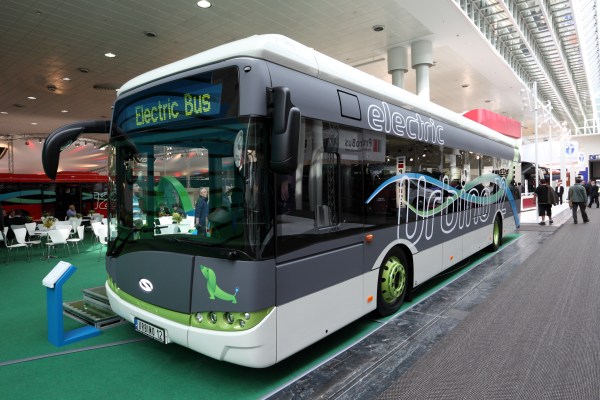Editor’s note: Michael Linse and Zach Barasz are investors with the Green Growth Fund at Kleiner Perkins Caufield & Byers.
Think of the vehicle that will change urban transportation. If the image in your mind is not an electric bus, you’re thinking of the wrong vehicle.
The electrification of the passenger vehicle has made headlines for good reason. Vehicles like the Tesla Model S and BMW i8 are beautiful and fast, and cars like the Chevy Volt and Nissan Leaf offer compelling value to commuters. But we’d be lucky if plug-in vehicles represent more than 5 percent of passenger vehicles sold in the United States over the next five years. Worries about range and cost are real, and it will take time to undertake the public effort – and build the charging infrastructure – to address consumer concerns.
Yet in other parts of the transportation industry, the electric drivetrain will experience much more rapid adoption. The most unexpected, and most impactful, shift will be for the mass transit bus.
A Bus Is the Perfect Use Case for an Electric Drivetrain
The electric drivetrain does a few things much better than a combustion engine. Electric motors have very high torque – buses are heavy, so they require high torque to accelerate. Electric motors can also deliver that torque at low speeds – buses stop and start often, so they require that power at low speeds. And batteries can recover energy from all of that braking.
As a result, an electric bus uses 20 percent of the raw energy of a diesel bus to go the same distance. In MPGe terms, a typical diesel bus may get 3.9 MPG – whereas an electric bus would get 21.4 MPGe. An electric drivetrain is also easier to take care of than an engine with controlled fuel explosions, more moving parts, filters and fluids.
The net result is that the total lifetime cost to own and operate an electric bus is 35 percent lower than that of a diesel bus. In five years, as battery and other costs come down, that advantage will only increase.
If you could buy a Tesla for less than an equivalent product and simultaneously save well over 50 percent on operating costs, the purchase decision would probably be quite easy. That is the kind of decision that transit operators will face in 2020.
Batteries Are Cheap in the Context of a Bus
Battery cost is a key barrier to adoption of electric vehicles, whether in a car or in a bus. However, a transit bus travels 3.5x more miles per year and carries 6x more passengers than a car, on average, so the battery cost is spread over 20x more “passenger miles” in a bus versus a car. Net, the real cost of the battery is multiples cheaper in a bus than a car, suggesting that the transit industry will shift toward electric vehicles before passenger cars.
Furthermore, batteries keep dropping in price. In 2015, price per kWh of automotive lithium-ion batteries was 60 percent lower than in 2010. In another five years, prices will likely drop by a similar percentage. Some analysts project that Tesla’s Gigafactory will drive so much volume that costs for batteries could decline by over 80 percent. And new technologies may completely transform the cost curve. All of this means that the case for electric buses will become more and more compelling over time.
But why do buses matter? Won’t everyone be taking Uber in the future anyway?
Public Transit Is a Killer App in People Moving
A public transit system is the cheapest way, per mile, to get from A to B. No matter how many miles you drive per year, if public transit is an option, it is cheaper than owning a car, car-sharing, or ridesharing.
Within public transportation, buses are extraordinarily efficient versus other options. The New York Times recently noted how much money governments spend on light rail as opposed to improving and marketing existing bus systems. A transit bus line is much cheaper than light rail to build, and offers unparalleled flexibility. Add electric to the mix, and that transit bus line is also half as expensive to run.
The Environmental Case
In addition to making immense financial sense, the transition to EV bus transit is important for urban environments. Even after taking into account the emissions from the electricity generation, an electric bus emits 4-6x fewer greenhouse gases than a bus that runs on diesel or natural gas. As solar and other renewables continue to increase as a percent of energy produced, the greenhouse gas emissions from electric vehicles will continue to fall.
Improves Transportation Today, and Solves Problems of Tomorrow
Most cities were designed when less than a third of the population lived in urban areas. Today, over half of humanity lives in cities, and that will grow to two-thirds by 2050. Reliance on the passenger car has created substantial costs from congestion. In the U.S. alone, congestion cost the economy $124 billion in 2013, or 0.7 percent of GDP – two Googles in revenue. We will need multiple solutions for addressing this congestion, including car sharing and ridesharing, but the electric bus is the killer solution for the modern city.
New entrants to the bus industry, including Bay Area-based Proterra (disclosure: Michael Linse is Chairman of Proterra) and the Chinese battery maker BYD, as well as incumbents such as New Flyer and Volvo, are understanding the transformative impact of the electric bus.
By 2020, we expect a majority of transit buses sold in the U.S. to be electric, and we expect the availability of highly efficient, low cost, zero emissions, and quiet electric buses to lead to a renaissance of urban transit in the United States.
